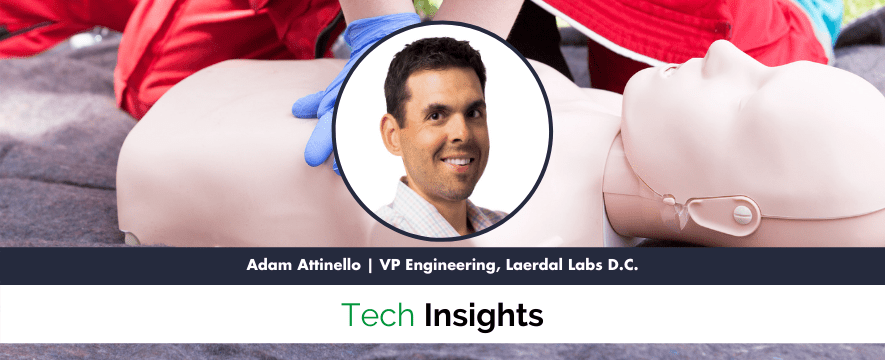Large organizations are seen as the slow and complex Goliaths to the nimble and swift startup.
But thousands of mergers, acquisitions, and partnerships each year mean that innovative startups are often brought into the corporate environment.
How can startups and organizations best learn and benefit from each other?
To learn more, we spoke with Adam Attinello, VP of Engineering at Laerdal Labs D.C. (formerly B-Line Medical), about his experience during B-Line’s acquisition by Laerdal Medical.
This conversation has been edited for clarity and length.
Can you tell us about your experience transitioning from a small team at B-Line to the corporate environment at Laerdal?
B-Line Medical had been around for about 15 years. They were a founder-funded, profitable business with 75 employees. In 2019, we were acquired by Laerdal Medical, and went from 75 people, mostly in the U.S., to a company with a large global footprint in 30 countries and about 1,500 people. In May of 2021, we officially rebranded from B-Line Medical to Laerdal Labs D.C.
Coming in, I had this fallacy that smaller companies could be more agile and could change direction faster than larger companies.
In some instances, that’s still true but in others, it’s not.
Within a small company, there is quicker and easier communication between groups. At a larger organization, it’s a more defined process.
At our DC office, when the software development group had a new release, they’d put a link to the JIRA in Slack and say, “Here’s the new release. Go read about it.” Plus, we’d walk over and let the support team know and they’d send out an email.
Running the software development group at the D.C. office of Laerdal, my team can still be that agile with our internal processes. We can still tweak our roadmap and schedule based on our needs.
But coordination with other groups requires that we slow down and make sure processes are followed.
When we had a new release, I’d lean over to the VP of Sales and put something on the calendar the week after to communicate with the 8-10 person sales team.
Now when we have a new release, we have an internal marketing manager that helps us get that communication out so I can update 600 people in 13 different languages.
It’s not that a larger company moves slower. The product and development group still moves quickly. Sometimes it’s even quicker when there are resources and backing from senior management. But when you need to reach out and have cross-group collaboration, there are processes to follow since you’re updating a larger group of people.
With the pandemic and working for a healthcare company, we were able to make pivots that I know would’ve been harder if we didn’t have Laerdal’s resources.
Was the acquisition a surprise or did you have an opportunity to prep the engineering team?
We were lucky in the way this came about.
We had formed a partnership with Laerdal, a year before the acquisition, where they used our software to replace a piece of software that they were sunsetting. We got our product exposed to a global community and were able to dip our toe into the water of their engineering culture.
As a smaller company, we used to joke about the complexity of the process. After being acquired, we see how the processes made further communication and collaboration across the organization much easier.
What were the biggest changes to your engineering team?
Both companies had similar cultures and missions.
At our D.C. office, we aimed to help make better healthcare professionals to save more lives.
Laerdal’s mission is to help save more lives.
When B-Line was acquired, the executive team at Laerdal told us that they wanted us to continue what we were doing best. They would handle areas where we were weak or didn’t have experience.
They were also flexible in letting us keep our tech stack. They use Office 365, while we used Google apps and Slack. They didn’t want to slow us down so things were left as is.
On the other hand, our D.C. office had outsourced I.T. and helpdesk. Laerdal had a great I.T. team that enables us to get the support we need internally.
What did your engineering team do well that you brought over to Laerdal?
Laerdal did not have as many cloud offerings.
They were originally a plastics company making toys and then made the first-ever CPR resuscitation mannequin in the 1960s. From there they got into high-fidelity medical simulation.
At their backbone, they’re still a mannequin and hardware company. They make a lot of software to aid and function those mannequins, but a lot of that is done in a traditional manner of getting a license, downloading software, and connecting to the hardware.
At our D.C. office, we made a transition a couple of years ago to become a cloud-based offering. We have a lot of internal knowledge about how to automate processes, how to do cloud deployments, and what makes sense (and doesn’t make sense) to do on AWS. We’ve been sharing a lot of what we’ve learned with engineering teams at Laerdal.
Small companies don’t have time to manually do things. The developers at our DC office were looking to automate and script as much as possible. At larger companies, you can get away with fixing things with people through contractors or consultants.
For example, when we first started translating our files, they were sent to a contractor and it would go through a two-month translation process for every new release.
We wanted to automate this process. We used Google translation service through Google Cloud and it let us build a machine learning network. We sent the translations from Google Cloud to native speakers across the 30 global offices. They would then check them and make edits to make sure the context was correct for the medical field. Those fixed translations were then fed back into the machine learning process so it could learn what we expect and responses we want back for certain words.
Now we can translate all our software in a few seconds for a fraction of the price. That’s where the automation and processes that would be built at a small company can benefit an entire organization.
How has your engineering team integrated with the existing development teams?
With cloud releases, there are a lot of external audits and processes. Those steps can take months, whereas we have biweekly releases and sometimes daily hotfixes. We haven’t slowed down our release cycle, but we were able to work with the organization and develop a new process on how to get releases out and update the whole organization.
We still very much work like a startup, we have our own culture, roadmaps, budgets, processes, tools, etc. We get to keep doing the same things we did best, but we now have this giant global network and resources to accelerate even faster.
They didn’t want to slow us down. When you’re entering a merger, acquisition, or partnership, be honest about what you do well and don’t do well. Recognize what the other team brings. Then be willing to learn from each other.
All the developers across Laerdal have been interested in learning about our culture, technologies, and processes. Likewise, we’ve learned about what teams across different time zones are working on and solutions they’ve built that we can adopt.
Communication is key to sharing ideas and technology with each other so you can save time and resources.





